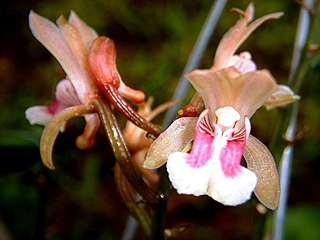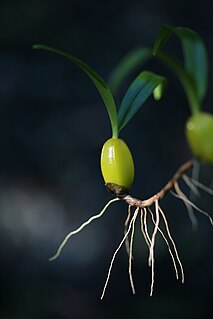
Coelogyne pandurata is a species of orchid. It is found in Malaysia, Sumatra, Borneo and the Philippines as a large sized, hot growing epiphyte found on large trees near rivers or terrestrial with well-spaced, strongly compressed, oblong or suborbicular, sulcate pseudobulb carrying 2, apical, plicate, elliptic-lanceolate, leaves with a stout petiole that blooms in late spring-summer out of the center of new leads with up to 15 flowers on a terminal, arched to pendant, 6 to 12" [15 to 30 cm] long, racemose inflorescence. The simultaneously opening flowers are highly fragrant of honey but are short lived. This orchid needs wire basket culture as it spreads out quite rapidly and sphagnum with wood chips as media works best and the best time to repot is when the new lead emerges.

Dendrobium kingianum, commonly known as the pink rock orchid, is a flowering plant in the orchid family Orchidaceae and is endemic to eastern Australia. It usually grows on rocks, rarely as an epiphyte, and has thin, spreading leaves and spikes of up to fifteen, usually pink flowers in late winter to spring. It is popular in Australian native horticulture and is a commonly cultivated orchid among Australian orchid species growers.

Calanthe triplicata commonly known as the common Christmas orchid is a plant in the orchid family and is native to Oceania, Asia, and the islands of eastern Africa. It is a terrestrial orchid that grows in clumps with crowded pseudobulbs, dark green corrugated leaves and up to forty white flowers. The sepals and petals are similar to each other and the labellum has three spreading lobes and a yellow callus.

Cymbidium canaliculatum, commonly known as the channelled boat-lip orchid, tiger boat-lip orchid, native cymbidium or tiger orchid is a plant in the orchid family and is endemic to Australia. It is a clump-forming epiphyte with large, greyish green pseudobulbs, each with up to six curved, deeply channelled leaves and up to sixty fragrant, variably coloured flowers that often have spots and blotches and a white to cream-coloured labellum with red markings. This orchid usually grows in the forks or hollows of trees and is found from New South Wales to the northern parts of Western Australia.

Eulophila pulchra, commonly known as the gonzo orchid, is a plant in the orchid family and is native to areas from Tanzania and Mozambique to the Western Pacific Ocean. It is a terrestrial orchid with crowded, above-ground pseudobulbs, two or three leaves and pale yellowish green flowers with dull purple or red markings. It grows in plant litter in rainforests.

Bulbophyllum longiflorum, commonly known as the pale umbrella orchid, is a species of epiphytic or lithophytic orchid. It has a creeping rhizome, widely spaced, dark green pseudobulbs with a single large, fleshy leaf, and flowers spreading in a semicirclar umbel, resembling one-half of an umbrella. The flowers are canoe-shaped, greenish cream-coloured to yellowish with purple dots. It has a wide distribution and is found in parts of Africa, on islands in the Indian and Pacific Oceans, Southeast Asia, New Guinea and northern Australia.

Dendrobium aemulum, commonly known as the ironbark feather orchid or white feather orchid, is an epiphytic orchid in the family Orchidaceae and grows on trees that retain their bark, especially ironbarks. It has reddish or purplish pseudobulbs, two to four leathery leaves and up to seven white, feathery flowers. It grows in open forest in Queensland and New South Wales.

Spathoglottis paulinae, commonly known as the small purple orchid, is a plant in the orchid family and is native to New Guinea and Tropical North Queensland. It is an evergreen terrestrial orchid with crowded pseudobulbs, between four and seven large, pleated leaves and up to thirty mauve to purple flowers.
Oeceoclades angustifolia is a terrestrial orchid species in the genus Oeceoclades that is endemic to southwestern and northern Madagascar. It was first described by the German botanist Karlheinz Senghas in 1966 as Eulophidium angustifolium. When Leslie Andrew Garay and Peter Taylor revised the genus Oeceoclades in 1976, they transferred this species to the expanded Oeceoclades. The type specimen was collected by Werner Rauh near the town of Sakaraha and the Fiherenana River.
Oeceoclades ambrensis is a terrestrial orchid species in the genus Oeceoclades that is endemic to northern Madagascar, where it grows in humid forests at altitudes of 1,000–1,100 metres (3,300–3,600 ft). It was first described by the French botanist Joseph Marie Henry Alfred Perrier de la Bâthie in 1951 as Lissochilus ambrensis and moved to the genus Eulophia in 1975 by Friedhelm Reinhold Butzin. It was last transferred to the genus Oeceoclades in 2001 by Jean Marie Bosser and Philippe Morat. The type specimen was collected in 1924 from montagne d'Ambre, now a part of Amber Mountain National Park. The pseudobulbs are fusiform (spindle-shaped) and homoblastic. Oeceoclades ambrensis is most similar to O. pulchra but it differs in the structure of the labellum, having rounded lobes.
Oeceoclades flavescens is a terrestrial orchid species in the genus Oeceoclades that is endemic to northeastern Madagascar. It was first described by the French botanists Jean Marie Bosser and Philippe Morat in 2001. The type specimen was collected in 1954 from the wet undergrowth of a coastal forest near Maroantsetra; it is the only known collection of this species. The specific epithet flavescens refers to the pale yellow flowers.
Oeceoclades furcata is a terrestrial orchid species in the genus Oeceoclades that is endemic to northwestern Madagascar, where it grows in sandy soils. It was first described by the French botanists Jean Marie Bosser and Philippe Morat in 2001. The type specimen was collected in 1943 by the French botanist Raymond Decary from the Soalala District; this is the only known specimen of the species. The specific epithet furcata refers to the distinctive forked floral spur.
Oeceoclades humbertii is a terrestrial orchid species in the genus Oeceoclades that is endemic to southeastern Madagascar, where it grows in xerophilous bush at altitudes from 500 to 600 m. It was first described by the French botanist Joseph Marie Henry Alfred Perrier de la Bâthie in 1939 as Lissochilus humbertii and moved to the genus Eulophia in 1975 by Friedhelm Reinhold Butzin. It was last transferred to the genus Oeceoclades in 2001 by Jean Marie Bosser and Philippe Morat. The type specimen was collected from the left bank of the Manambolo valley in the Mandrare River basin in either December 1933 or January 1934 when it was recorded as flowering by its collector Jean-Henri Humbert for whom the specific epithet humbertii honors. The small pseudobulbs are conical and heteroblastic. Oeceoclades humbertii is distinguished from all other Oeceoclades by its completely green flowers. It has only been collected twice including the type specimen; the other specimen was collected by Philippe Morat in 1973 from the Onilahy valley in the Ankazoabo gorges north of Betioky.
Oeceoclades longebracteata is a species of terrestrial orchid in the genus Oeceoclades that is endemic to southwestern and south-central Madagascar. It was first described by the French botanists Jean Marie Bosser and Philippe Morat in 2001. The type specimen was collected in 1970 by Jean Marie Bosser from dry forest undergrowth near Tsaramasao, 20 km (12 mi) south of Sakaraha. The specific epithet longebracteata refers to the long bracts found along the inflorescence.
Oeceoclades beravensis is a terrestrial orchid species in the genus Oeceoclades that is endemic to the southern and western Madagascar where it grows in the sandy soils of western dry forests and wooded grasslands. This species has cane-like stems and forms dense clumps in the understorey, a feature that makes it unique among the Eulophiinae species found in Madagascar. Like other orchid species in Eulophia and Oeceoclades that are adapted to arid climates, O. beravensis has narrow and coriaceous leaves with minute serrations.
Oeceoclades callmanderi is a species of terrestrial orchid in the genus Oeceoclades that is endemic to northeastern Madagascar, where it grows in the coastal forests of Cape Masoala. It was first described by the French botanist Jean Marie Bosser in 2006 and named in honor of one of the collectors, M. W. Callmander.

Dendrobium finniganense, commonly known as the Mount Finnigan cane orchid, is a species of terrestrial or lithophytic orchid endemic to a few mountain tops in far north Queensland, Australia. It has narrow, cylindrical pseudobulbs, each with up to three thin, dark green leaves and usually only one or two white to cream-coloured flowers with yellow and purple markings near the centre.
Dendrobium eungellensis, is an epiphytic orchid in the family Orchidaceae and is endemic to northern Queensland. It has dark greenish brown pseudobulbs with up to three leaves on the end and up to eight fragrant white flowers with thin, spreading sepals and petals. It grows in open forest in the Eungella National Park.
Dendrobium coriaceum, commonly known as the inland rock orchid, is a species of lithophytic orchid that is endemic to North Queensland. It has tapered pseudobulbs, up to three thick, leathery leaves and up to forty yellow or cream-coloured flowers with purple markings on the labellum.















